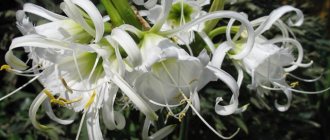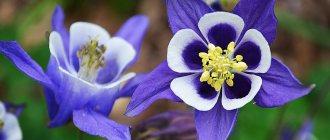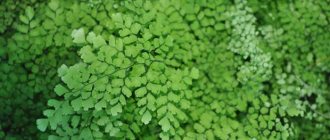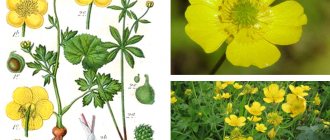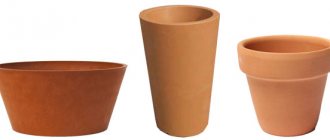Nephrolepis is a type of fern that arrived in the apartment of a resident of a modern metropolis from tropical and subtropical forests. The plant is most widespread in the southeastern regions of Asia, where it originally grew. A large number of Nephrolepis species in the wild are also present today in African and American countries.
Description
Nephrolépis is a southern herbaceous plant that usually leads a terrestrial or epiphytic lifestyle.
Nature has endowed it with a short rhizome, a lush rosette of light green leaves, dotted with numerous veins, spreading in all directions, the length of which in most cases reaches 70 cm. The plant also has numerous leafless shoots, which are covered with small scales and can easily take root, giving life new generations of plants. In addition to its stunning appearance, nephrolepis surprises flower growers with its unique properties: like other plants, it is capable of purifying the surrounding air, but it does this much more “professionally” than its green neighbors in the garden. Thus, this plant is capable of purifying the air from toxic substances such as formaldehyde and toluene in record time.
In ancient times in Africa, there was a belief that nephrolepis prevents any human diseases from developing. Today, scientists have discovered the secret behind such superstitions: the plant is capable of killing most types of pathogenic microbes that are released into the air by sick people. This fact makes Nephrolepis especially useful for growing in hospitals and clinics.
When cultivating nephrolepis at home, gardeners who want to emphasize the spreading nature of the plant’s lush leaves resort to using hanging flowerpots. Apart from its obvious aesthetic function, this allows the fern's leaves to develop to an even larger size than could be achieved if Nephrolepis were grown in a regular pot.
Beneficial features
This fern purifies the air from household gas, neutralizes the effects of all kinds of aerosols and cleaning products, glue, varnishes, and electromagnetic radiation.
It is recommended to get nephrolepis for people who often experience nervous stress or with weak immunity. Nephrolepis are ideal for rooms filled with heavy energy.
Tips for flower growers:
- place nephrolepis near the TV in winter; its radiation will be beneficial to the plant;
- ferns look better if they stand apart from other plants;
- it grows well near an aquarium with fish;
- many varieties of nephrolepis are sterile, so they can only be propagated vegetatively;
- It is better to buy ferns during the period when the heating is not working in the apartments; at this time it is easier for them to adapt, because the natural air humidity in the rooms at this time is higher than during the heating period;
- Brown spots on the bottom of the leaves are not a disease.
Video on the topic
Learn interesting facts about the Nephrolepis fern from the video below:
Types and varieties
In nature there is a wide range of species and varieties of nephrolepis, each of which differs in the structure of the leaf blade, flowering period, and requirements for living conditions. Unfortunately for many gardeners, only two varieties of plants can be grown at home to “adult” sizes. We are talking about Nephrolepis sublime and Nephrolepis cordifolia. Let's look at each type of amazing flower separately.
Nephrolepis exaltata
The most commonly grown species of nephrolepis. This fern attracts the attention of gardeners for its unpretentiousness, which allows the plant to reach its maximum size even with little care. The distinctive features of the flower include a high, erect root and single-pinnate leaves (vai), the length of which can reach 60 cm and a width of 10 cm. The leaves themselves are collected in a rosette and have a light green color. Individual leaves or segments of fronds, as a rule, grow up to 3-7 cm in length and have a width of up to 1.2 cm. Changes in the humidity regime do not prevent Nephrolepis sublime from actively growing and developing.
There are several varieties of this species:
- Nephrolepis Green Lady is distinguished by lush spreading leaves crowning the rhizome growing in all directions with a lush spherical bunch. Green Lady is of particular interest to most gardeners, as it is one of the most beautiful subspecies of this crop. Contrary to the opinion that this variety, due to its increased sensitivity to growing conditions, is almost impossible to keep indoors, you can acquire this plant and place it in the garden.
Nephrolepis Green Lady
- Nephrolepis Emina (Nehprolepis Emina) attracts the attention of gardeners with its compact size, as it grows primarily not in breadth, but upward, reaching about 45-50 cm. Curly leaves with jagged dark green edges grow vertically upward. The Emina variety also requires abundant watering.
Nephrolepis Emina
- Nephrolepis Boston has dark green dissected leaves (foreheads) that grow up to 1.2 m. The frond segments along the edges are twisted or covered with waves.
Nephrolepis Boston
Nephrolepis curly
Nephrolepis curly
This species got its name due to its lacy feathery leaves with wavy edges. To create comfortable conditions for nephrolepis curly, it is necessary to ensure an increased moisture content in the soil. In addition, this fern requires warmth, otherwise the tropical plant may die from the cold.
Nephrolepis Vitale
Nephrolepis Vitale
It has thin, openwork green fronds. The Vitale species requires partial shade to grow and develop well.
Nephrolepis Sonata Nephrolepis Sonata
Nephrolepis Sonata Nephrolepis Sonata
A small representative of nephrolepis has short light green leaves, which are collected in lush rosettes. The height of the plant is usually only 45-55 cm.
The lush and neat fern resembles a sphere in its shape. Like many other subspecies of nephrolepis, the Sonata species requires an increased level of soil moisture for growth and development.
Nephrolepis Green Moment Nephrolepis Green Moment
Nephrolepis Green Moment Nephrolepis Green Moment
Mainly grown in botanical gardens and greenhouses. If you decide to grow the Green Moment species in your summer cottage, you may encounter certain difficulties, since the plant prefers shaded areas and grows better under artificial light than under the influence of sunlight.
This species has oblong-shaped shoots that hang down from the pot, which makes the fern look like a living fountain. The leaf blades are dark green in color and have curled edges.
Nephrolepis Exaltata
Endowed with long, lush leaves of dark green color, collected in a rosette.
Nephrolepis Exaltata is additionally attractive due to its amazing unpretentiousness to external conditions and care. With all this, the appearance of the flower invariably remains “at its best”.
Nephrolepis Duffy
Nephrolepis Duffy
The flower is endowed with relatively small curved leaves of a round shape and amazes with the richness of the dark green shades of the leaf plates.
With the proper level of care, the plant can reach 1 m in height, which makes it more suitable for a greenhouse or garden than an apartment window sill.
Nephrolepis cordifolia
Nephrolepis cordifolia
This species has several distinctive features and is distinguished by the presence of numerous swellings located on underground shoots, the shape of which can be compared with the shape of tubers. The number of swellings can reach 200. They are used by the plant to store nutrients and water, and are also directly involved in the processes of fern reproduction. The leaves of this type of nephrolepis grow straight up.
The leaf segments are located very tightly to each other, as a result of which they create a semblance of a heart, which is where the name of the species comes from. The leaves grow up to 30-60 cm in length and up to 5-6 cm in width. The frond segments, as a rule, do not exceed 3 cm in length and 1.5 cm in width.
These features make nephrolepis cordifolia the most recognizable among other species and prompt many gardeners to choose it for cultivation.
Nephrolepis blechnum Nephrolepis Blechnum
Nephrolepis blechnum Nephrolepis Blechnum
A distinctive feature of this species are palm-shaped leaves, the length of which reaches 1 meter. The leaves are pale green in color and are collected in a dense rosette located at the top of a shortened stem. This plant looks very similar to a low palm tree.
The frond segments have an oval-elongated shape and are deeply cut and pinnately dissected.
Nephrolepis Greed Fantasy
Nephrolepis Greed Fantasy
The dark green leaf blades are quite short and have curly edges that hang down from the pot, forming a lush fountain.
Preferred for this type is partial shade or artificial lighting.
Nephrolepis Green Dragon
Nephrolepis Green Dragon
The compact fern has dark green leaf blades that do not grow more than 50 cm. The leaves grow vertically upward and somewhat resemble sheets of corrugated paper. This representative requires high humidity in order to feel comfortable.
Nephrolepis Falkata
Nephrolepis Falkata
A rather large species, the leaf blades of which can grow up to 120 cm, with leaf segments reaching 10 cm in size. The leaves have jagged edges of a yellow-green color. The plant has an unusual appearance due to the fact that the base of the leaves is slightly curved.
Nephrolepis Macho
Nephrolepis Macho
The dark green fronds grow up to 50-60 cm in length and attract attention with their beautiful wavy edges.
Nephrolepis Macho prefers conditions with high humidity, so if you decide to grow the plant at home, do not forget to provide it with regular, abundant watering.
Nephrolepis Marisa
Nephrolepis Marisa
A miniature fern, the size of the leaves does not exceed 50 cm. The leaves have wavy, pinnately dissected segments of rich green color.
Nephrolepis Variegata (exaltata Tiger eye)
Nephrolepis Variegata (exaltata Tiger eye)
It has medium-sized light green leaf plates covered with dark veins. The leaves grow vertically upward and reach a length of about half a meter.
Nephrolepis biserrata
Nephrolepis biserrata
This species, also known as the Giant Sword Fern, is native to Central and South America and Southeast Asia in the wild. Among other species, it is easy to find by the length of the leaf, which often reaches or exceeds 4 m; the width of the leaf can be about 75 cm. Individual leaves can grow up to 23 cm in length. With proper plant care, you can grow a true, “natural” size African fern in your garden or yard.
Nephrolepis ensiform is an excellent greenhouse plant, the dimensions of which can surprise even the most demanding audience.
Features of cultivation
Soil selection
The most favorable soil for nephrolepis is considered to be a mixture of humus, leaf and peat soil, as well as coarse sand in a ratio of 1:2:1:1. To improve, you can add a small amount of finely ground coniferous tree bark to the mixture.
You can also use special soil for ferns, which is sold in any store.
When growing a fern in a pot, it is better to put a little small expanded clay at the bottom. This will not allow a large amount of moisture to accumulate at the roots of the flower and will prevent rotting.
When choosing a container for growing this crop, give preference to wide and shallow pots. Such characteristics are best suited for the superficial root system of nephrolepis.
Location and lighting
In the wild, nephrolepis can be found only in shady areas illuminated by diffuse sunlight.
When growing a plant at home or in a summer cottage, you can safely plant it in partial shade or shade. When you decide to decorate your apartment with a similar crop, place the flower pot on a window facing north. Nephrolepis will grow even in the bathroom if it is equipped with a window.
Excessive sunlight will lead to slower plant growth and the formation of burns on sensitive leaf blades.
Temperature, humidity, watering
Nephrolepis is accustomed to moderate temperatures. In Africa, it usually grows near bodies of water, where air humidity is high most of the time and there is partial shade. Thus, the optimal temperature for nephrolepis will be within + 20 ... + 22 degrees.
If the temperature exceeds +28 degrees or drops below +14°C, flower growth will slow down significantly or stop altogether.
From March to October, a small amount of damp moss or expanded clay should be placed in the tray of the pot where nephrolepis is grown. Don't forget to moisturize them from time to time.
Fertilizers and fertilizers
Nephrolepis needs weekly feeding during the growing season, which lasts from April to October. In this case, you should use organic or mineral fertilizers intended for ferns.
In winter, during the dormant period, fertilizers should be applied no more than once a month, alternating between organic and mineral compounds. The solution used for fertilizing should be weak, which will not disturb the soil balance.
There are several options for feeding nephrolepis:
- root - fertilizer is applied to the soil and absorbed by the roots;
- foliar - the nutrient mixture is absorbed through the leaves. This method is used if the plant is weak and cannot be fertilized by the root method.
Only mature crops with a strong root system need feeding. Under no circumstances should nephrolepis be fertilized when the soil in the pot is dry, as this can lead to burns to the roots.
As for feeding plants grown in the garden, it is recommended to regularly spray them with a urea solution prepared at the rate of 1 gram of urea per liter of water.
Transfer
In order for the fern to grow well and not get sick, in the first years of its life it needs an annual transplant, which is preferably carried out with the onset of spring.
A crop that has reached 3 years of age should be replanted no more than once every three years.
If you notice that nephrolepis is cramped in its pot, be sure to transplant it into a larger container. This will speed up the growth and development of the plant.
When replanting, use the same substrate that was used for the first planting. Remember that it is necessary to create a drainage layer of expanded clay.
Trimming
The plant needs improvement and regular pruning. Forgetting about this, you will soon notice that the leaf plates have begun to turn yellow and die, and numerous children will also form. To avoid this, it is necessary to regularly carry out the pruning procedure, during which you remove dried branches and yellowed leaves. Children should be pruned during fern transplantation.
Winter care
Ferns are not flowering plants. For this reason, stimulating the formation of buds using a dormant period is pointless.
If the place where the plant is grown is a window sill, then a decrease in daylight hours and a drop in temperature will automatically lead to the plant going into a dormant period. In this case, the soil will begin to dry out less often, and, as a result, you will need to reduce watering.
The main thing is to control that the room temperature does not drop below +14 degrees, and also to protect the plant from drafts. If the temperature in the room, which is usual for summer, has been maintained, caring for the crop should be carried out according to the same principles as before.
If there are heating devices in the house that make the air dry, it is necessary to spray nephrolepis more often.
You can lengthen the plant's daylight hours by using an ordinary phytolamp.
It is advisable to reduce the amount and frequency of feeding during this period to once a month.
Reviews about the plant
This is one of the most unpretentious ferns, a very spectacular plant.
I dearly love this unpretentious indoor fern. In September, I planted a huge basin-like pot, and everyone was gifted with ferns. But it didn’t start growing well for me right away. First, I managed to get a plant with three half leaves, around which I danced with a tambourine, I really wanted a big beautiful fern. But my dancing didn’t bother him one bit, and he kept standing there, apparently wondering whether life was worth living. And so, while digging through the Internet in search of an answer to what he needs, I came across a recipe that I want to share. To replant, you need to dilute the soil very generously with pine bark. We also add pieces of coal, pine litter, and you can add sphagnum moss. It wouldn’t hurt to mix in some sand if the land is purchased, otherwise there is usually only peat. And it’s better to take a flat pot, not a tall one. Transplanted in this way, my little one somehow quickly recovered and began to grow, and now there are no problems with it. But it does not like drying out, and it is better to monitor the soil moisture. After all, it stands high, and the fact that it is dry is not immediately noticeable. The fronds do not wither, but just somehow turn pale and begin to dry out at the tips of the leaves. But the saddest thing is that the “snails” dry up without having time to turn around. A beautiful house plant, unpretentious and grateful for care, I recommend it! irkin44 https://irecommend.ru/content/zelenyi-vodopadik-sekret-uspeshnoi-posadki
I have the same.
It needs to be moved to the window, otherwise the leaves are long and sparse. But when it fluffs up - oh, and handsome! All the guests are looking in. Elf https://otzovik.com/review_217759.html
I've had ferns for a long time, about 15 years to be exact.
I'm always surprised when you complain about the lack of light for them. In my experience, they are only beautiful and green in winter. When spring comes and the sun comes, they begin to turn pale. If I take them out into the yard and onto the completely shady side, where the sun never hits them, it’s the same thing. They become pale. Here are mine on the veranda in winter, now I have already taken them off and hid them in the northern rooms. Jike https://forum.bestflowers.ru/t/nefrolepis-nephrolepis.146911/page-51
I love this plant for its luxurious thick greenery, for the interesting observation of how a beautiful carved frond appears from the “snails”, and so on ad infinitum!
My little children kept coming up and waiting for little green, furry balls to appear on the surface of the earth, changing in size every day. The plant survives quite well. But if you want it to be a rich green color, it needs to be provided with favorable conditions. The main thing is not to overwater, often spray with settled water, do not feed with fertilizers, it is enough to fertilize twice with liquid fertilizer for ornamental flowering plants. In very bright light, nephrolepis fronds turn pale, so it should not be placed on a southern window. But it also fades in the shadows. The most successful window will be the eastern one. On New Year's Day we decorate it with rain, it looks very original. A very good fern with lush forms. Clarice https://irecommend.ru/content/ochen-khoroshii-paporotnik-s-pyshnymi-formami-foto
I love ferns; I have several of them at my summer cottage.
Maybe that’s why I love nephrolepis, because it is also a representative of ferns. Amazingly beautiful at home. It is not difficult to grow, it grows very quickly and is unpretentious. It prefers moist soil, likes spraying, grows well in partial shade, fertilizing is needed from time to time. Anna Zakharchuk https://flap.rf/Animals_and_plants/Nephrolepis/Reviews/6437440
Reproduction methods
Disputes
In nature, ferns reproduce by spores. It is quite difficult to carry out this process at room conditions. First of all, it is necessary to prepare disputes. To do this, the leaf segment with the spores formed on it is cut off and the spores are carefully separated, transferring them to paper, after which they are thoroughly dried and sown in early spring.
A small amount of drainage is added to the new pot intended for planting, and the soil mixture intended for sowing spores is laid on top. After this, you should moisten the soil generously, disperse the spores evenly, and cover the nursery with protective glass. Finally, the pot is placed in a dark, warm place.
The protective glass should be removed regularly (preferably every day). This will ensure ventilation of the plants. If necessary, sprinkle the soil with a small amount of soft rainwater, which will prevent the soil from drying out.
Having placed the so-called nursery in a dark place, leave it there until the first shoots of young ferns appear. As a rule, this occurs 1-3 months after the seeds are introduced into the soil.
After the seedlings emerge, remove the protective glass and place the pot in a more illuminated place. When the new generation of nephrolepis grows up, it is worth thinning them out, during which it will be necessary to leave only the largest, most viable plants. They should be placed at a distance of at least 2-3 cm from each other. After several leaves form on the nephrolepis seedlings, transplant them into separate containers for further cultivation.
By shoots
An easier process of propagation of nephrolepis involves the use of terrestrial leafless pubescent shoots. In order to get new plants, you first need to press a few shoots of the mother plant to the ground using pins and wire. You should regularly water these shoots and keep the soil around them moist. After the shoots produce several young leaves, they need to be transplanted into separate pots.
Dividing the bush
If you decide to propagate nephrolepis by dividing the bush, you will need to separate the part of the plant that has several growth points and plant it in a separate pot with prepared soil mixture. It is most convenient to do this during the process of transplanting the mother flower. In order for a young plant to quickly take root and grow stronger, the air temperature should be maintained at least +15 degrees and high humidity should be provided.
Moisture contents
Air humidity is a significant factor and the key to the longevity of a fern representative. Maintaining comfort involves daily application of water from a spray bottle.
On too hot days, the procedure is repeated 2-3 times, and every four weeks you can organize a shower, after covering the top soil layer with film to avoid waterlogging.
Possible problems
Most often, you may encounter problems such as changes in leaf color to yellow and complete drying of the fronds.
In the event that this happens to an old leaf blade, there is no need to worry - this is a natural process of death. However, if young, newly emerged leaves turn yellow, you should pay attention to the conditions in which the crop is kept. So, the cause of this problem may be keeping the plant in too dry air.
There are situations when brown spots form on the surface of the leaf plates. This is a sign that the plant is suffering from exposure to too much sunlight.
On the contrary, too pale leaf color may indicate a lack of lighting.
Nephrolepis will not grow well if there is not enough space. In this case, it is necessary to transplant the plant into a wider pot.
If the plant has stopped producing new shoots, and the color of the existing ones has become too pale, then this is a signal that the fern does not have enough nutrients. In this case, it is necessary to fertilize the plant.
Diseases and pests
Nephrolipis is a plant that is resistant to pests, but with improper care and non-compliance with the conditions of its maintenance, the protective forces are weakened.
Most often, nephrolipis is attacked by scale insects, spider mites, whiteflies and mealybugs. To control pests, you should use natural insecticides such as alcohol or a solution of laundry soap.
Signs of a fungal infection include blackening and rotting of leaves. In this case, it is necessary to immediately remove the affected leaf blade.
Nephrolepis is an excellent choice for both experienced and beginner gardeners. This plant will be an excellent element of landscaping at home, office or garden. Even in conditions of lack of sunlight, nephrolepis will feel great and will be able to please you with a lush mop of vegetation. In addition, the culture will saturate the surrounding air with oxygen, clean it of impurities and fumes harmful to households.
Turning to folk beliefs and signs, it is recommended to start growing nephrolepis for those who are particularly shy and lack self-confidence. It is believed that the plant gives the owner confidence and also attracts harmony into the house.
Nephrolepis - signs
Fern nephrolepis is a very popular plant, maybe that’s why there are legends about it, it is the central character of many superstitions and signs. Some talk about the positive effect of the plant on human health and the environment, while others attribute witchcraft properties to nephrolepis that can influence a person’s fate. An ancient legend says that none of the people could see the fern flower, because on the night of Ivan Kupala, when it blooms, it is plucked by an invisible hand, and all sorts of mystical horrors await those who go into the forest in search of this flower.
Another belief says that the fern scares away evil spirits, protects the house from evil witchcraft and black magic, preventing the evil eye or damage from being cast on the owners. They also say that fern brings success in business, has a positive effect on material well-being - it attracts money into the house, protects its owners from irrational actions and impulsive spending. It is said that there have been cases of sudden enrichment that are associated with the presence of ferns in the house.
If people of different temperaments live in a house, fern helps to establish good harmonious relationships between them. Under the influence of his aura, aggressive manifestations of people’s character are softened, temper goes away, and confrontation is smoothed out. This is probably why nephrolepis is called the “golden mean” plant.
Which of the stories about ferns is true and which is fiction, everyone decides for themselves. However, I must say that I personally have not felt any negative effects of indoor nephrolepis on my life. For me, nephrolepis is a non-capricious, spectacular plant that brings beauty to the house, purifies the air in the apartment and creates a cozy atmosphere. And let me finally give you some advice: do not be afraid to grow nephrolepis in your home and do not listen to those who themselves live with fears and prejudices.
